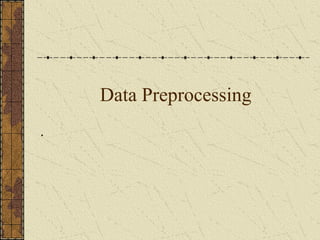Data preprocessing is important for obtaining quality data mining results. It involves cleaning data by handling missing values, outliers, and inconsistencies. It also includes integrating, transforming, reducing and discretizing data. The document outlines various techniques for each task such as mean imputation, binning, and clustering for cleaning noisy data. Dimensionality reduction techniques like feature selection and data compression algorithms are also discussed.
















![Example:
Suppose that the minimum and maximum values
for the attribute income are $12,000 and $98,000,
respectively. We would like to map income to the
range [0.0, 1.0].
Suppose that the mean and standard deviation of
the values for the attribute income are $54,000 and
$16,000, respectively.
Suppose that the recorded values of A range from
–986 to 917.](https://image.slidesharecdn.com/data1-140304030411-phpapp02/85/Data1-17-320.jpg)


















![Binning
Attribute values (for one attribute e.g., age):
0, 4, 12, 16, 16, 18, 24, 26, 28
Equi-width binning – for bin width of e.g., 10:
Bin 1: 0, 4
[-,10) bin
Bin 2: 12, 16, 16, 18
[10,20) bin
Bin 3: 24, 26, 28
[20,+) bin
– denote negative infinity, + positive infinity
Equi-frequency binning – for bin density of e.g.,
3:
Bin 1: 0, 4, 12
Bin 2: 16, 16, 18
Bin 3: 24, 26, 28
[-, 14) bin
[14, 21) bin
[21,+] bin](https://image.slidesharecdn.com/data1-140304030411-phpapp02/85/Data1-36-320.jpg)
